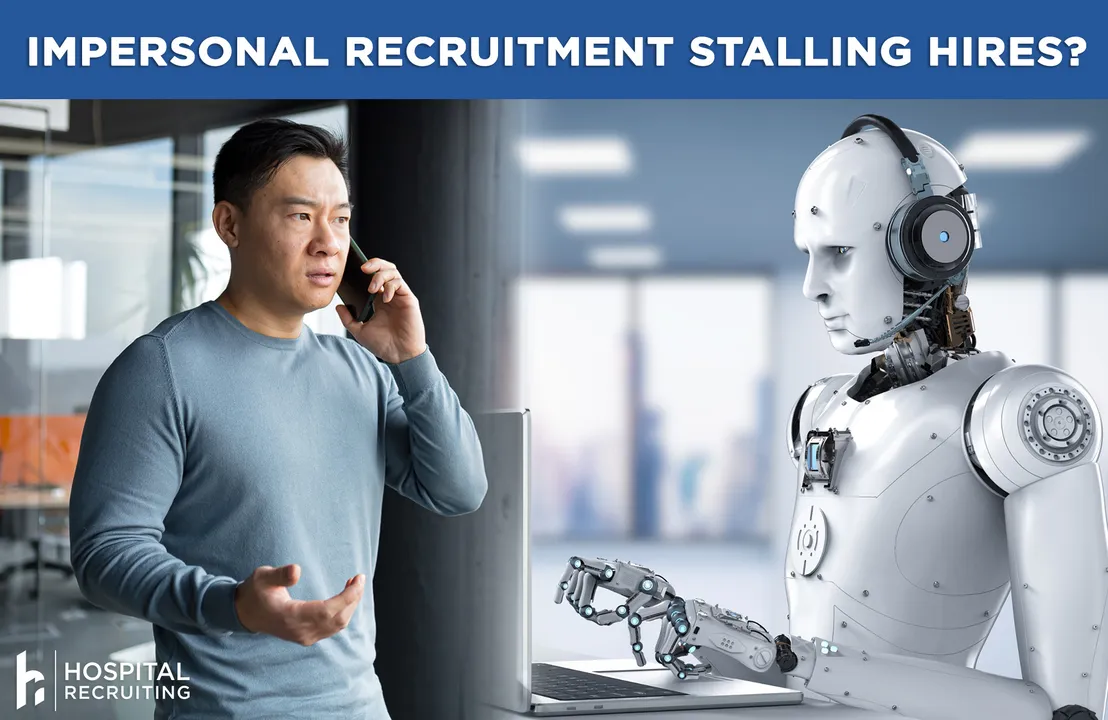Is Impersonal Recruitment Stalling Your Hiring Efforts?

If you’ve ever been trapped in a voicemail maze, you know how frustrating it can be to wait for an actual human to get on the line. How many times have you given up on the call? Automation may be a necessity in many industries due to staffing shortages, but its price is often customer care. When it comes to recruitment, a personal touch may be required to assure you’re attracting top clinicians.
When asked, almost 70% of job seekers believed the hiring process was too impersonal; 80% admitted sending their resume to an anonymous address was like putting it in a ‘black box.’ Hospital recruitment professionals know the value of making a connection early on with a candidate — and keeping it. The stronger the link, the higher the chances of a new hire.
From the job posting through the offer letter, the more personal you can make the process, the higher your conversion to hire rate will be. With more communication tools at your disposal than ever before, there’s no reason for anonymous recruitment when it comes to top tier talent.
No resume required
For top tier positions in your facility, consider posting with a ‘no resume required’ option. You’re telling the applicant you know they’re busy and in demand and you’re willing to do the work for them.
Ask the candidate to email or text a link to an online profile that outlines their education, experience, and preferences. A LinkedIn page, or something similar, gives as much (or more) information than a resume. It delves deeper into experience, education, and outside interests.
If you post a ‘no resume required’ position, make sure to notify candidates you’ve received their link and will contact them as soon as you’ve had a chance to review their profile. By valuing their time at this early stage of the hiring process, you establish how much you value your employees.
Post personally
Even if the ‘person’s’ email is a dummy account, post your vacancies with the name, phone, and email address of a person. When applicants send in their resumes or CVs, they begin the process believing they’re making a one-to-one connection. Call them immediately, if you’re interested, and let them know ‘Recruiter X’ forwarded their resume to you for immediate attention.
Text over email
Candidates prefer text communication over emails because it establishes a real-time conversation. Phone calls can be ill-timed or intrusive, but many clinicians are able to respond to text messaging even when they’re in the middle of another task. You’ll frequently get an ‘I’ll be in touch in a half hour’ if they’re busy. Much better than wondering if they’ve even heard your voice message or read your email.
Make sure your posting offers candidates options to be contacted by phone, text, or email messaging. And be sure to issue recruitment staff institutional phones so their personal lines aren’t overwhelmed with messages.
Make a connection
However you begin the interchange with an applicant, make and maintain a personal connection as quickly as possible. If you’re impressed with their CV, schedule a lunch, rather than an interview, for the first meeting. Touch briefly (after you’ve eaten) about their background but focus more on selling your institution. Talk about your mission, vision, and commitment to the community and patients. Let their first connection establish your willingness to put in the time and effort to demonstrate why they should join your team.
Stay connected
Throughout the process, communication is key. As you and the candidate wait for interviews to be held or decisions to be made, keep the connection open. Let them know what the timeline to hire is and stick with it. But touch base during interims to let them know things are moving along and they’re still top of mind and top of the list.
Plan on connecting later
We’ve all lost potential new hires during the recruitment process, but that doesn’t mean we should sever the connection. If the applicant went with another offer, wait a few months, then check back in to see if they’re happy where they landed. A good percentage of new hires regret their decision in the first 6 months. You may contact someone who thought they had a better opportunity that wasn’t as advertised and may be able to re-recruit them.
If the applicant came in second in the process, you’ve probably already assured them your choice was difficult. You should also have told them you’ll be contacting them as soon as another opportunity pops up. Even if a vacancy doesn’t open immediately, check in periodically to maintain that connection. It may pay off in the short- or long-term with a candidate who’s already vetted and ready for hire.

As talent shortages continue, recruiters will need to get more creative than ever to entice applicants to their institutions. Making sure your processes are personal, proactive, and value the job seeker’s time may be an advantage your facility has over the competition.
Related Posts
